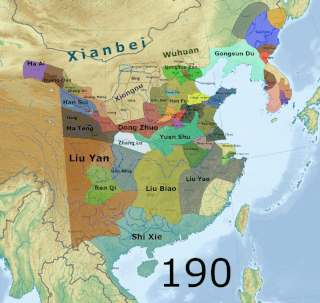Our website is made possible by displaying online advertisements to our visitors.
Please consider supporting us by disabling your ad blocker.
Yan (Three Kingdoms)
Yan 燕 | |||||||||
|---|---|---|---|---|---|---|---|---|---|
| 237–238 | |||||||||
 Time-lapse of the multiple various conquests and territorial changes of the Three Kingdoms era, the State of Yan only briefly existed though the region had been ruled by the Gongsun Clan for decades before its conquest in 238 | |||||||||
| Status | Kingdom | ||||||||
| Capital | Xiangping[1] | ||||||||
| Government | Monarchy | ||||||||
| King | |||||||||
• 237–238 | Gongsun Yuan | ||||||||
| History | |||||||||
• Established | July 237 | ||||||||
• Officially claimed dependency to Eastern Wu | January 238 | ||||||||
• Attacked by Sima Yi | June 238 | ||||||||
• Conquered | 29 September 238 | ||||||||
| Population | |||||||||
• 237 CE | about 300,000[2] | ||||||||
| |||||||||
| Today part of | China | ||||||||
Yan (Chinese: 燕) was a Chinese kingdom that existed from July 237 to September 238 CE in the Liaodong Peninsula during the Three Kingdoms period.[1][3] Its predecessor was an independent regime ruled by Gongsun Du and his son Gongsun Kang from 190 to 237. Though it only claimed independence in 237, historians such as Wang Zhongshu and Hou Tao consider it to be a de facto independent regime from when Gongsun Du established his rule in Liaodong in 190.[4][5] Although it existed during the Three Kingdoms period, it is not counted as one of the eponymous three kingdoms: Cao Wei, Shu Han, and Eastern Wu. Nevertheless, writers such as Kang Youwei consider it to be a "fourth country".[6]
- ^ a b 原遙平 (2018-10-23). 圖解三國時代 更新版 (in Chinese (Taiwan)). 易博士. p. 89. ISBN 978-986-480-064-3.
- ^ 金鑠. "漢族之發展與東北之開闢" (PDF). Cheng Kung journal of historical studies. Retrieved 2020-04-21.
- ^ Ikeuchi, pp. 87–88
- ^ Wang, Zhongshu (2005). 中日两国考古学, 古代史论文集 (in Chinese). 科学出版社. p. 315. ISBN 9787030161062.
- ^ 侯涛 (2011). "三国演义其实是四国争霸". 当代人:下半月 (1): 79–81.
- ^ Kang, Youwei (2013-10-21). 歐洲十一國遊記二種 (in Chinese (Taiwan)). 群出版. p. 98.
Previous Page Next Page


